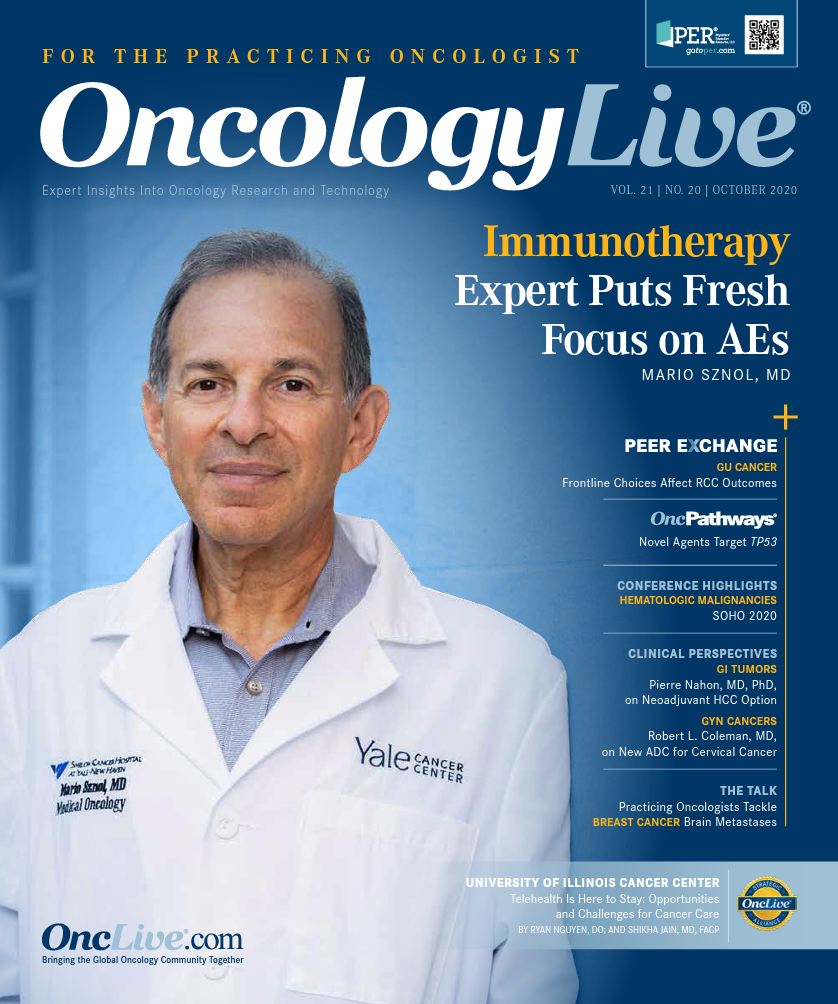Quad Therapy Induces Deep Responses in Black Patients With Multiple Myeloma
Data from a subgroup analysis of the phase 2 GRIFFIN study demonstrated that adding daratumumab to lenalidomide, bortezomib, and dexamethasone improved depth of response, stringent complete response, and minimal residual disease negativity, in Black patients with newly diagnosed multiple myeloma.
Ajay K. Nooka, MD, MPH

Data from a subgroup analysis of the phase 2 GRIFFIN study demonstrated that adding daratumumab (Darzalex) to lenalidomide (Revlimid), bortezomib (Velcade), and dexamethasone (RVd) improved depth of response, stringent complete response (sCR), and minimal residual disease (MRD) negativity, in Black patients with newly diagnosed multiple myeloma.
Thirty-two Black patients received either RVd plus daratumumab (D-RVd; n = 18) or RVd (n = 14). Investigators reported that the sCR rate was higher for Black patients who received D-RVd versus RVd (71% vs 33%) at the end of the consolidation phase. The odds ratio was 5.00 (95% CI, 1.10-22.82; 2-sided P = .0353). Similar efficacy was reported in White patients, with higher sCR rates observed with the 4-drug regimen (n = 85) versus the 3-drug regimen (n = 76; 43% vs 34%, respectively). The OR for sCR at the end of consolidation among White patients was 1.46 (95% CI, 0.76-2.82; P = .2620).1
“This analysis is not meant to provide a direct comparison between the Black or the White patients,” said lead author Ajay K. Nooka, MD, MPH, during a presentation at the Society of Hematologic Oncology 2020 Virtual Annual Meeting.1 “The intent is to determine if daratumumab can benefit patients who are African American or not.”
The subgroup analysis sought to elucidate a greater understanding of the differences in outcomes for Black patients versus White patients based on a primary analysis of the GRIFFIN study (NCT02874742), said Nooka, an associate professor at the Department of Hematology and Medical Oncology at Emory University School of Medicine and medical director at the Winship Cancer Institute of Emory University.2 Historically, Black patients have had poorer outcomes than White patients, although when given equal access to care, they have similar or better outcomes relative to White patients.3,4
The primary end point of the GRIFFIN trial was sCR following allogeneic stem cell transplant and was evaluable in 106 patients of the overall population. The prespecified median follow-up was 13.5 months. The sCR rates favored D-RVd (n = 99) versus RVd (n = 97) at 42.4% versus 32.0%, respectively (OR, 1.57; 95% CI, 0.87-2.82; 1-sided P = .068), meeting the prespecified 1-sided α of 0.10.2
Further, responses continued to deepen at last follow-up. At median follow-up of 22.1 months, sCR rates were 62.6% for patients treated with D-RVd versus 45.4% for those who received RVd, demonstrating that the addition of the anti-CD38 antibody essentially doubled the likelihood of achieving sCR (OR, 1.98; 95% CI, 1.12-3.49; P = .0177).2 Improved MRD-negativity rates were also observed in the intention-to-treat population in 51.0% (51/104) and 20.4% (21/103), respectively; (P < .0001).2
“By the end of the consolidation phase, the sCR rate was improved for D-RVd versus RVd in both patient populations,” Nooka said.
Response Data Show Similar Improvement
The overall response rate (ORR) was 100% and 94% for D-RVd and RVd, respectively, in Black patients, with similar findings reported for White patients (Table).1 “The responses deepened over time in both the Black patients and White patients with a complete response of 21% by the end of transplant, which increased to 86% by the end of consolidation, with 71% of these found to be stringent complete responses,” Nooka said. This improvement was observed for all time points among Black patients who received daratumumab.1
Table. Stratified Response Rates in the GRIFFIN Study1

By the end of post-transplant consolidation, MRD negativity at the 10-5 threshold was significantly higher in the daratumumab arm, at 36% with D-RVd compared with 17% with RVd in Black patients. In White patients, MRD negativity was 49% in the D-RVd group compared with 16% in the RVd group.1
Regarding toxicities, the most common any-grade treatment emergent adverse events (TEAEs) in Black patients were neutropenia (57%), anemia (50%), leukopenia (43%), thrombocytopenia (43%), and lymphopenia (36%) for the D-RVd arm. In White patients, toxicity rates were similar with 58% experiencing neutropenia, followed by thrombocytopenia (45%), leukopenia (25%), anemia (34%), and lymphopenia (30%) for the D-RVd arm. The rate of grade 3 or 4 TEAEs in the D-RVd versus RVd arms was 79% versus 83% for Black patients, and 83% versus 76% for White patients, respectively.1
“Overall, higher rates of grade 3 and 4 neutropenia, leukopenia, and thrombocytopenia were observed for D-RVd in Black and White subgroups,” Nooka said. The most common nonhematologic TEAEs among Black patients treated with D-RVd were upper respiratory tract infection, fatigue, and constipation.
Treatment discontinuation occurred in 36% and 28% of Black patients in the D-RVd and RVd arms, respectively, and in 11% and 16%, respectively, of White patients. Among Black patients, 5 patients in each treatment arm discontinued RVd, with the most frequent cause attributed to peripheral neuropathy or neuralgia. Infusion-related reactions to daratumumab occurred in 29% of Black patients and 45% of White patients and were generally mild (grade 1 or 2). There were zero deaths reported for either subgroup.1 Overall, the safety profile of D-RVd among Black patients was consistent with that of White patients, Nooka said.
“In Black patients with newly diagnosed multiple myeloma, using D-RVd as induction and consolidation therapy improved depth of response, including the rate of sCR and MRD negativity,” Nooka said. “These results support D-RVd as a potential new standard of care for Black patients who are transplant eligible and newly diagnosed.”
References:
- Nooka AK, Kaufman JL, Rodriguez C, et al. Daratumumab + lenalidomide/bortezomib/dexamethasone in African Ameri-can/Black patients with transplant-eligible newly diagnosed multiple myeloma: subgroup analysis of GRIFFIN. Presented at: Society of Hematologic Oncology 2020 Virtural Annual Meeting; September 9-12, 2020; virtual. Abstract MM-350.
- Voorhees PM, Kaufman JL, Laubach J, et al. Daratumum-ab, lenalidomide, bortezomib, and dexamethasone for transplant-eligible newly diagnosed multiple myeloma: the GRIFFIN trial. Blood. 2020;136(8):936-945. doi:10.1182/blood.2020005288
- Costa LJ, Brill IK, Omel J, Godby K, Kumar SK, Brown EE. Recent trends in multiple myeloma incidence and surviv-al by age, race, and ethnicity in the United States. Blood Adv. 2017;1(4):282-287. doi:10.1182/bloodadvanc-es.2016002493
- Fillmore NR, Yellapragada SV, Ifeorah C, et al. With equal access, African American patients have superior survival compared to white patients with multiple myeloma: a VA study. Blood. 2019;133(24):2615-2618. doi:10.1182/blood.2019000406




